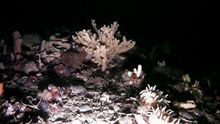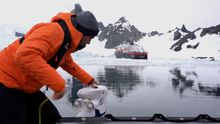 06 Jun 2024
06 Jun 2024
Tags: HX

London, UK – In a pioneering collaboration, expedition specialists HX and esteemed ichthyologist Dr. Manuel Novillo join forces for the groundbreaking project, "Exploring the Unseen", aboard HX's hybrid-battery vessel, MS Roald Amundsen. This initiative aims to uncover secrets of the Antarctic Ocean floor, pinpointing vital spawning grounds for historically overexploited fish species. Offering a rare glimpse beyond the snow, icebergs, whales and penguins usually associated with this region, the project reveals vibrant and concealed ecosystems hidden within the icy Antarctic waters.
During January and February, Dr. Novillo, in collaboration with the expert expedition team on the MS Roald Amundsen, led this thrilling initiative to pioneer a new approach in establishing a monitoring program for Antarctic fish spawning grounds. Furthermore, they captured footage of seldom-seen Antarctic landscapes and unearthed the otherworldly wildlife thriving beneath the waves.
Highlights from the initial phase of the project include:
- Deploying a state-of-the-art underwater drone in Marguerite Bay, below the Antarctic Circle, offering unprecedented insights into the uncharted waters surrounding Stonington Island, discovering marine life rarely seen by human eyes. Such as several species of plump and colourful, sponge-eating starfish; bottlebrush-like sea pens, a type of soft-coral; various, tubular, horny and warty-looking sponges; large, slow-growing Antarctic scallops; rusty orange, leathery looking sea squirts; and icefish.
- Achieving a groundbreaking feat by setting a new company record for drone deep diving in Orne Harbour, descending to an impressive depth of 115 meters.
- Capturing awe-inspiring footage of a seabed covered with porcelain-like brittlestars in Deception Island, reminiscent of extraterrestrial beings, and a peculiar feathery-looking crinoids, relatives of starfish, in Horseshoe Island. These curious creatures were much more abundant in the Jurassic Period; hence they are now more commonly found as fossils in limestone outcrops on land.
- During the 16 drone deployments, from depths of 10m – 115m across 11 sites, fish species were observed in six locations, and fish guarding a nest was identified, resulting in a successful initial phase for the research project.
The successful launch of the inaugural "Exploring the Unseen" science boat marked a significant milestone, allowing guests to actively participate in the drone deployment process and fostering a deeper appreciation for the fragile marine ecosystem of the Southern Ocean.
"This research goes beyond science communication; it's about making a real impact," said Dr. Verena Meraldi, Chief Scientist at HX, expressing excitement about the project's potential. "I'm thrilled to see our underwater drones utilised to their full potential, contributing to a project that holds immense promise."
Dr. Manuel Novillo expressed gratitude for the support and enthusiasm surrounding the project, emphasising its significance for future research endeavours. "This is just the beginning," Dr. Novillo remarked. "I'm immensely grateful for the opportunity to delve into the mysteries of the Antarctic depths, and I'm eager to see where this journey takes us when we return next year. Hopefully we will identify new fish spawning grounds and work hard to protect these important areas.”
Despite encountering challenges posed by harsh environmental conditions and technological limitations, the project has made remarkable strides in its initial phase. The state-of-the-art Science Center onboard MS Roald Amundsen has provided an exceptional platform for this groundbreaking research, generating considerable interest among guests and crew alike.
-ENDS-
Notes to editor
About HX
In 1896, HX (Hurtigruten Expeditions), set out on a journey of exploration from its homeland in Norway. Driven by a passion to discover what lies beyond the horizon, they sailed in the wake of the pioneering seafarers who were redrawing the world's boundaries.
Today, HX is the leading expedition cruise company, taking guests to over 250 destinations in more than 30 countries worldwide. With onboard lectures and science centres, HX is committed to ensuring guests return home with a deep understanding and love of the places they explore.
HX is on a mission to be the world's most-sustainable expedition company. They led the industry by being the first to ban heavy fuel oil and single-use plastics. In 2019, HX unveiled the world's first battery hybrid-powered cruise ship.
Alaska | Antarctica | Galapagos | Greenland | Iceland | Northwest Passage | Svalbard
About Dr. Manuel Novillo
Dr. Manuel Novillo is a marine biologist graduated on the National University of Córdoba, Argentina. He is also a professional scientific diver, and media storyteller (@novillomanu). During his PhD he focused his research on Antarctic marine ecosystems, mainly on fish reproductive ecology. As an early career researcher, he has published several articles in highly qualified peer-reviewed journals. As a postdoctoral researcher at the Instituto de Diversidad y Ecología Animal (IDEA-CONICET), he is evaluating the role inshore areas have as spawning grounds for Antarctic fish. Given the current global warming scenario, he is evaluating the incidence of rising water temperatures in the reproductive cycle of Antarctic fish (Novillo et al. 2021, 2024).
In the last years, Manuel has participated as group leader of the Ichthyology group in 6 Antarctic campaigns (Argentinean Antarctic Institute). For each campaign, he spent 3-4 months conducting research in scientific stations located on the West Antarctic Peninsula (Carlini and Brown stations). Moreover, he has participated as a scientific diver in several expeditions along the Patagonian kelp forests to register the fish species diversity.
Manuel is also an excellent storyteller who participated in the 2023 Natural History Media Lab organized by Santiago Wild Film Festival and National Geographic Society support. He will actively work to disseminate the scientific results of “Exploring the Unseen” (@exploring.theunseen) and create media content on social networks with lovely images and a powerful narrative to raise awareness of the importance of protecting the Antarctic ecosystem.
Novillo M, Elisio M, Moreira E, Macchi G, Barrera Oro E (2024) First insight into the influence of temperature on reproduction in Antarctic fish: the case of Notothenia coriiceps. Estuar Coast Shelf Sci 10.1016/j.ecss.2024.108629
Novillo M, Elisio M, Moreira E, Macchi G, Barrera Oro E (2021) New insights into reproductive physiology in Antarctic fish: a trial in Lepidonotothen nudifrons. Polar Biology. Polar Biol 44:1127–1139




